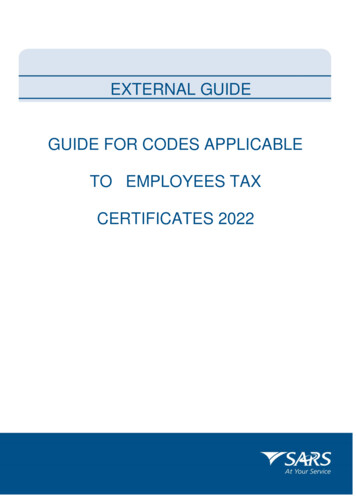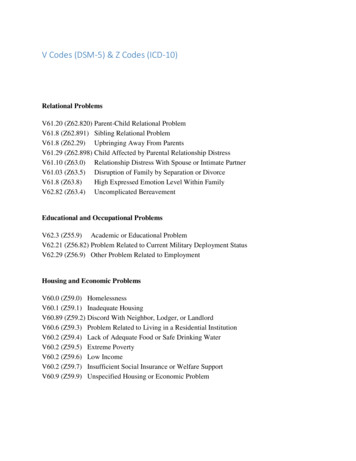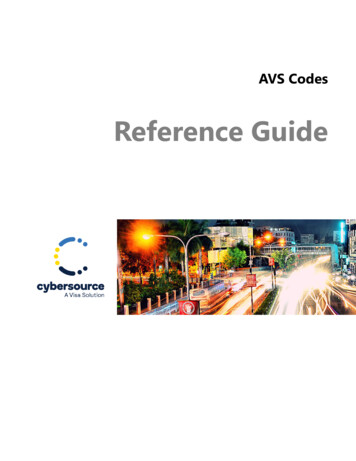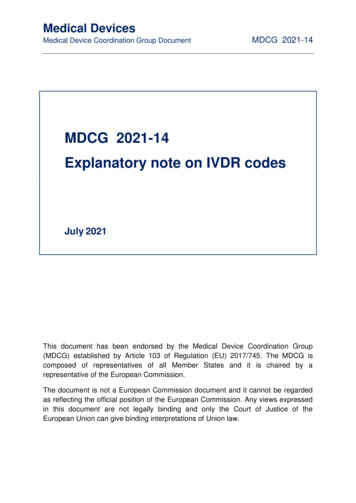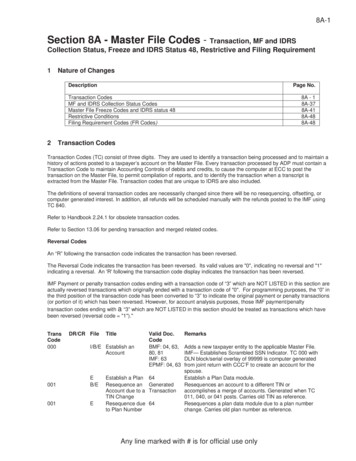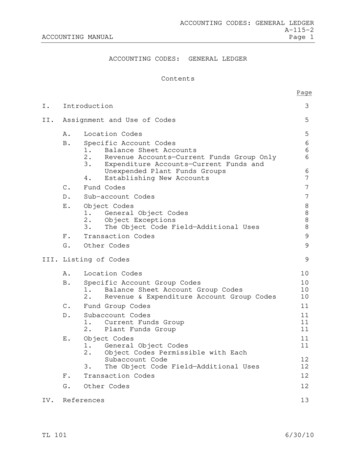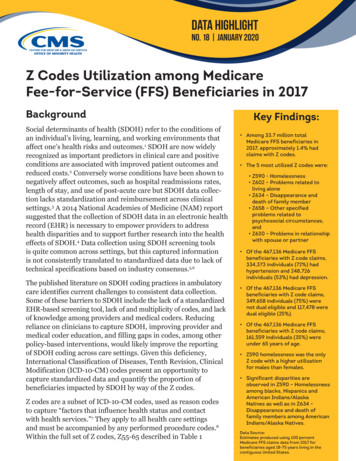![Table 1 [ IMG1]: Codes To Identify Neuroimaging In Administrative .](/img/42/chipra-0198-tables1-9.jpg)
Transcription
Table 1 [ IMG1]: Codes to Identify Neuroimaging in Administrative ClaimsImaging ModalityComputerized Tomography (CT) ofBrain/HeadMagnetic Resonance Imaging (MRI) ofBrain/HeadCode TypeRevenue (UB-92)350, 351, 352, 353, 354, 355, 356, 357, 358, 359CPT70450, 70460, 70470, 70480, 70481,70482ICD-9-CM87.03Revenue (UB-92)610, 611, 612, 613, 614, 615, 616, 617, 618, 619CPT70551, 70552, 70553ICD-9-CM88.91Table 2[ IMG2]: Epilepsy and Recurrent SeizuresGeneral DiagnosisEpilepsy and recurrent seizuresGeneralized non-convulsiveGeneralized convulsivePetit mal statusGrand mal statusLocalized-related (focal) (partial) epilepsy andepileptic syndromes with complex partial seizuresLocalized-related (focal) (partial) epilepsy andepileptic syndromes with simple partial seizuresInfantile spasmsEpilepsia partialis continuaOther forms of epilepsy and recurrent seizuresEpilepsy, unspecifiedGeneral SymptomsCodesDiagnosis DetailsICD-9-CM CodeAbsences (atonic, typical), minorepilepsy, petit mal, pykno-epilepsy,seizures (akinetic, atonic)Epileptic seizures (clonic, tonic,myoclonic, tonic-clonic), grand mal,major epilepsyEpileptic absence statusStatus epilepticus NOSEpilepsy (limbic system partial,psychomotor, psychosensory, temporallobe), Epileptic automatismEpilepsy (Bravais-Jacksonian NOS, focal(motor) NOS, Jacksonian NOS, motorpartial, partial NOS, sensory-induced,somatomotor, somatosensory, visceral,visualHypsarrhythmia, Lightning spasms,Salaam attacksKojevnikov’s epilepsyCursive [running] gelasticEpileptic convulsions, fits or seizuresNOS, recurrent seizures NOS, seizuredisorder NOS345.0Simple febrile seizureComplex febrile seizurePost-traumatic seizure780.31780.32780.33Other .7345.8345.9
Table 3 [ IMG9]: Head Trauma and Intracranial HemorrhageGeneral DiagnosisPost-traumatic headacheConcussionFracture of skullConcussionDiagnosis DetailWith no loss of consciousnessWith brief loss of consciousnessClosed w/o mention of intracranial injuryClosed with cerebral laceration and contusionClosed with subarachnoid, subdural and extraduralhemorrhageClosed with other and unspecified intracranial hemorrhageClosed with intracranial injury of other and unspecified natureOpen w/o mention of intracranial injuryOpen with cerebral laceration and contusionOpen with subarachnoid, subdural and extraduralhemorrhageOpen with other and unspecified intracranial hemorrhageOpen with intracranial injury of other, unspecified natureFracture of skull baseOther, unqualified skull fractureMultiple fractures involving skull or face with other bonesWith loss of consciousness (LOC) 30min or lessWith LOC 31 minutes to 59 minutesWith moderate LOC (1-24 hours)With prolonged LOC and return to pre-existing conscious levelWith prolonged LOC, without return to pre-existing consciouslevelWith loss of consciousness of unspecified durationConcussion, unspecifiedCerebral laceration and contusionSubarachnoid, subdural, extradural hemorrhage post injuryOther/unspecified intracranial hemorrhage following injuryIntracranial injury of other and unspecified natureSubarachnoid hemorrhageIntracerebral hemorrhageOther and unspecified intracranial hemorrhageChild abuse and neglectObservation and evaluation for – abuse and neglectLate effect of fracture of skull and face bonesLate effect of intracranial injury without mention of skullfractureICD-9-CM 2.x995.5xV71.81905.0907.0
Table 4 [ IMG5]: Neoplasm/Blood DisorderGeneral DiagnosisMalignant neoplasm of brainMalignant neoplasm of pituitary glandMalignant neoplasm of pineal glandSecondary malignant neoplasm of other sites – brainBenign neoplasm of brainBenign neoplasm of cranial nervesBenign neoplasm of cerebral meningesNeoplasm of uncertain behavior – pituitaryNeoplasm of uncertain behavior – pineal glandNeurofibromatosisPersonal history of malignant neoplasm of – brainSickle cell diseasePancytopeniaCoagulation defectsPurpura and other hemorrhage conditionsOther specific diseases of blood and blood forming organsAnticoagulants (Adverse Effects in Therapeutic Use)Long-term (current) use of anticoagulantsLong-term (current) use of antiplatelets/antithromboticsDiagnosis DetailQualitative platelet defectsPrimary thrombocytopenia2ndary thrombocytopeniaThrombocytopenia, unspecifiedOther specified hemorrhagicconditionsUnspecified hemorrhageconditionsPrimary hypercoagulable state2ndary hypercoagulable stateICD-9-CM .8287.9289.81289.82E934.2V58.61V58.63
Table 5[ IMG6]: Hydrocephalus and Central Nervous System AnomaliesGeneral DiagnosisPrecocious pubertyHydrocephalusObstructive hydrocephalusCongenital hydrocephalusSpina bifida with hydrocephalusMechanical complication of CNS device, implant, graftInfection and inflammatory reaction due to CNS device,implant, and graftOther complications of internal prosthetic device,implant, and graft due to CNS device, implant, and graftPresence of cerebrospinal fluid drainage deviceMucopolysaccharidosis (hydrocephalus and seizure)CNS and skull anomaliesOther congenital anomalies of nervous systemReduction deformities of brainOther specified anomalies of brainConditions increasing risk for HydrocephalusOther congenital musculoskeletal anomaliesOther and unspecified congenital anomaliesOther conditions of the brainEncephalopathy, NECCNS complications from surgically implanted deviceDiagnosis DetailICD-9-CM 5EncephaloceleAbsence part of brain, agenesispart of brain, agyria, lissencephaly,microgyria, etcCongenital cerebral cyst,macrocephaly, etc742.0742.2Dwarfism, NOSAchondroplastic dwarfismSpina bifidaAnomalies of skull face bonesIncludes craniosynostosisTuberous sclerosisCerebral cystsIdiopathic 59.5348.0348.2348.31, 348.39349.1
Table 6 [ IMG7]: Congenital Heart DiseaseGeneral DiagnosisBulbus cordis/cardiac septal closure anomaliesOther congenital anomalies of the heartOther specified anomalies of the heartOther personal history presenting hazards to healthDiagnosis DetailCommon truncusTranspositionTetrology of FallotCommon VentricleVentricular Septal DefectAtrial septal defectEndocardial cushion defectsCor biloculareOtherUnspecifiedAnomalies of pulmonary valveTricuspid atresia and stenosisEbstein’s anomalyStenosis of aortic valveInsufficiency of aortic valveCongenital mitral stenosisCongenital mitral insufficiencyHypoplastic left heartSubaortic stenosisCor triatriatumInfundibular pulmonic stenosisObstructive anomalies of heartSurgery to heart and great vesselsICD-9-CM 1746.82746.83746.84V15.1
Table 7 [ IMG8]: Vascular DiseaseGeneral DiagnosisHemangioma of unspecified site(includes cavernous malformation)Phlebitis/thrombophlebitis of intracranial venous sinusesOcclusion and stenosis of precerebral arteriesOcclusion of the cerebral arteriesTransient cerebral ischemiaCerebral aneurysm, nonrupturedMoyamoya diseaseNonpyogenic thrombosis of intracranial venous sinusOther congenital anomalies of the circulatory systemOther specified anomalies of circulatory system(includes anteriovenous malformation)Other venous embolism/thrombosis unspecified siteOther and unspecified intracranial hemorrhagePersonal history of other certain diseasesDiagnosis DetailBasilar arteryCarotid arteryVertebral arteryMultiple and bilateralOther specifiedUnspecifiedCerebral thrombosisCerebral embolismCerebral artery occlusionBasilar artery syndrome, vertebralartery syndrome, etcCoartcation of the aortaOther anomalies of the aortaCerebrovascular anomaliesOther (aneurysm)TIA and cerebral infarctionICD-9-CM 9753.9432.xV12.5
Table 8 [ IMG4]: InfectionGeneral DiagnosisAmebic brain abscessTuberculosis of meninges and central nervous systemMeningococcal meningitisHIVMeningitis due to enterovirusOther enterovirus diseases of the central nervous systemOther non-arthropod-borne viral diseases of centralnervous systemPostvaricella encephalitisHerpes zoster with meningitisHerpetic meningoencephalitisHerpes simplex meningitisPostmeasles encephalitisRubella with neurological complicationsOther human herpesvirus encephalitisMosquito-borne viral encephalitisTick-borne viral encephalitisViral encephalitis transmitted by other and unspecifiedarthropodsWest Nile fever with encephalitisMumps meningitis/encephalitisMeningitisEncephalitis, myelitis, encephalomyelitisIntracranial and intraspinal abscessDiagnosis DetailICD-9-CM 72055.0056.0x058.2062.x063.x064066.41072.1, 072.2BacterialOther organismsUnspecified cause320.xx321.x322.x323.xx324.x
Table 9 [ IMG10]: CPT Codes to Identify Lumbar Puncture and Recent Neurosurgical ProceduresProcedureSpinal TapSpinal puncture lumbar diagnosticSpinal tapAnesthesia for dx or therapeutic lumbar punctureNeurosugeryTranscatheter placement of extracranial cerebrovascular artery stent(s), percutaneous; initialvesselEach additional vessel (list separately in addition to code for primary procedure)Transcatheter placement of extracranial cerebrovascular artery stent(s), percutaneous,radiological supervision and interpretation, each vesselAnesthesia for intracranial procedures; not otherwise specifiedAnesthesia for intracranial procedures; craniotomy or craniectomy for evacuation of hematomaAnesthesia for intracranial procedures; subdural tapsAnesthesia for intracranial procedures; burr holes, including ventriculographyAnesthesia for intracranial procedures; cranioplasty or elevation of depressed skull fracture,extradural (simple or compound)Anesthesia for intracranial procedures; vascular proceduresAnesthesia for intracranial procedures; procedures in sitting positionAnesthesia for intracranial procedures; cerebrospinal fluid shunting proceduresAnesthesia for intracranial procedures; electrocoagulation of intracranial nerveStereotactic placement of infusion catheter(s) in the brain for delivery of therapeutic agent(s),including computerized stereotactic planning and burr hole(s)Anesthesia for therapeutic interventional radiological procedures involving the arterial system;intracranial, intracardiac, or aorticAnesthesia for therapeutic interventional radiological procedures involving the venous/lymphaticsystem (not to include access to the central circulation); intracranialVentricular puncture through previous burr hole, fontanelle, suture, or implanted ventricularcatheter/reservoir; without injectionVentricular puncture through previous burr hole, fontanelle, suture, or implanted ventricularcatheter/reservoir; with injection of medication or other substance for diagnosis or treatmentCisternal or lateral cervical (c1-c2) puncture; without injection (separate procedure)Cisternal or lateral cervical (c1-c2) puncture; with injection of medication or other substance fordiagnosis or treatment (eg, c1-c2)Puncture of shunt tubing or reservoir for aspiration or injection procedureTwist drill hole for subdural or ventricular punctureTwist drill hole for subdural or ventricular puncture; followed by other surgeryTwist drill hole for subdural or ventricular puncture; for implanting ventricular catheter orpressure recording deviceTwist drill hole for subdural or ventricular puncture; for evacuation and/or drainage of subduralhematomaBurr hole(s) for ventricular puncture (including injection of gas, contrast media, dye, orradioactive material); followed by other surgeryBurr hole(s) or trephine; with biopsy of brain or intracranial lesionBurr hole(s) or trephine; with drainage of brain abscess or cystBurr hole(s) or trephine; with subsequent tapping (aspiration) of intracranial abscess or cystBurr hole(s) with evacuation and/or drainage of hematoma, extradural or subduralCPT 506115161154
ProcedureBurr hole(s); with aspiration of hematoma or cyst, intracerebralBurr hole(s); for implanting ventricular catheter, reservoir, eeg electrode(s), pressure recordingdevice, or other cerebral monitoring device (separate procedure)Insertion of subcutaneous reservoir, pump or continuous infusion system for connection toventricular catheterBurr hole(s) or trephine, supratentorial, exploratory, not followed by other surgeryBurr hole(s) or trephine, infratentorial, unilateral or bilateralCraniectomy or craniotomy, exploratory; supratentorialCraniectomy or craniotomy, exploratory; infratentorial (posterior fossa)Craniectomy or craniotomy for evacuation of hematoma, supratentorial; extradural or subduralCraniectomy or craniotomy for evacuation of hematoma, supratentorial; intracerebralCraniectomy or craniotomy for evacuation of hematoma, infratentorial; extradural or subduralCraniectomy or craniotomy for evacuation of hematoma, infratentorial; intracerebellarIncision and subcutaneous placement of cranial bone graft (list separately in addition to code forprimary procedure)Craniectomy or craniotomy, drainage of intracranial abscess; supratentorialCraniectomy or craniotomy, drainage of intracranial abscess; infratentorialCraniectomy or craniotomy, decompressive, with or without duraplasty, for treatment ofintracranial hypertension, without evacuation of associated intraparenchymal hematoma; withoutlobectomyCraniectomy or craniotomy, decompressive, with or without duraplasty, for treatment ofintracranial hypertension, without evacuation of associated intraparenchymal hematoma; withlobectomyDecompression of orbit only, transcranial approachExploration of orbit (transcranial approach); with biopsyExploration of orbit (transcranial approach); with removal of lesionExploration of orbit (transcranial approach); with removal of foreign bodySubtemporal cranial decompression (pseudotumor cerebri, slit ventricle syndrome)Craniectomy, suboccipital with cervical laminectomy for decompression of medulla and spinalcord, with or without dural graft (eg, arnold-chiari malformation)Other cranial decompression, posterior fossaCraniotomy for section of tentorium cerebelli (separate procedure)Craniectomy, subtemporal, for section, compression, or decompression of sensory root ofgasserian ganglionCraniectomy, suboccipital; for exploration or decompression of cranial nervesCraniectomy, suboccipital; for section of one or more cranial nervesCraniectomy, suboccipital; for medullary tractotomyCraniectomy, suboccipital; for mesencephalic tractotomy or pedunculotomyCraniotomy for lobotomy, including cingulotomyCraniectomy; with excision of tumor or other bone lesion of skullCraniectomy; for osteomyelitisCraniectomy, trephination, bone flap craniotomy; for excision of brain tumor, supratentorial,except meningiomaCraniectomy, trephination, bone flap craniotomy; for excision of meningioma, supratentorialCraniectomy, trephination, bone flap craniotomy; for excision of brain abscess, supratentorialCPT 14906150061501615106151261514
ProcedureCraniectomy, trephination, bone flap craniotomy; for excision or fenestration of cyst,supratentorialImplantation of brain intracavitary chemotherapy agent (list separately in addition to code forprimary procedure)Craniectomy for excision of brain tumor, infratentorial or posterior fossa; except meningioma,cerebellopontine angle tumor, or midline tumor at base of skullCraniectomy for excision of brain tumor, infratentorial or posterior fossa; meningiomaCraniectomy for excision of brain tumor, infratentorial or posterior fossa; cerebellopontine angletumorCraniectomy for excision of brain tumor, infratentorial or posterior fossa; midline tumor at base ofskullCraniectomy, infratentorial or posterior fossa; for excision of brain abscessCraniectomy, infratentorial or posterior fossa; for excision or fenestration of cystCraniectomy, bone flap craniotomy, transtemporal (mastoid) for excision of cerebellopontineangle tumor;Craniectomy, bone flap craniotomy, transtemporal (mastoid) for excision of cerebellopontineangle tumor; combined with middle/posterior fossa craniotomy/craniectomySubdural implantation of strip electrodes through one or more burr or trephine hole(s) for longterm seizure monitoringCraniotomy with elevation of bone flap; for subdural implantation of an electrode array, for longterm seizure monitoringCraniotomy with elevation of bone flap; for excision of epileptogenic focus withoutelectrocorticography during surgeryCraniotomy with elevation of bone flap; for removal of epidural or subdural electrode array,without excision of cerebral tissue (separate procedure)Craniotomy with elevation of bone flap; for excision of cerebral epileptogenic focus, withelectrocorticography during surgery (includes removal of electrode array)Craniotomy with elevation of bone flap; for lobectomy, temporal lobe, withoutelectrocorticography during surgeryCraniotomy with elevation of bone flap; for lobectomy with electrocorticography during surgery,temporal lobeCraniotomy with elevation of bone flap; for lobectomy with electrocorticography during surgery,other than temporal lobe, partial or totalCraniotomy with elevation of bone flap; for lobectomy, other than temporal lobe, partial or total,without electrocorticography during surgeryCraniotomy with elevation of bone flap; for transection of corpus callosumCraniotomy with elevation of bone flap; for total hemispherectomyCraniotomy with elevation of bone flap; for partial or subtotal (functional) hemispherectomyCraniotomy with elevation of bone flap; for excision or coagulation of choroid plexusCraniotomy with elevation of bone flap; for excision of craniopharyngiomaCraniotomy for hypophysectomy or excision of pituitary tumor, intracranial approachHypophysectomy or excision of pituitary tumor, transnasal or transseptal approach,nonstereotacticCraniectomy for craniosynostosis; single cranial sutureCraniectomy for craniosynostosis; multiple cranial suturesCraniotomy for craniosynostosis; frontal or parietal bone flapCraniotomy for craniosynostosis; bifrontal bone flapCPT 1557
ProcedureExtensive craniectomy for multiple cranial suture craniosynostosis (eg, cloverleaf skull); notrequiring bone graftsExtensive craniectomy for multiple cranial suture craniosynostosis (eg, cloverleaf skull);recontouring with multiple osteotomies and bone autografts (eg, barrel-stave procedure)(includes obtaining grafts)Excision, intra and extracranial, benign tumor of cranial bone (eg, fibrous dysplasia); without opticnerve decompressionExcision, intra and extracranial, benign tumor of cranial bone (eg, fibrous dysplasia); with opticnerve decompressionCraniotomy with elevation of bone flap; for selective amygdalohippocampectomyCraniotomy with elevation of bone flap; for multiple subpial transections, withelectrocorticography during surgeryCraniectomy or craniotomy; with excision of foreign body from brainCraniectomy or craniotomy; with treatment of penetrating wound of brainTransoral approach to skull base, brain stem or upper spinal cord for biopsy, decompression orexcision of lesion;Transoral approach to skull base, brain stem or upper spinal cord for biopsy, decompression orexcision of lesion; requiring splitting of tongue and/or mandible (including tracheostomy)Craniofacial approach to anterior cranial fossa; extradural, including lateral rhinotomy,ethmoidectomy, sphenoidectomy, without maxillectomy or orbital exenterationCraniofacial approach to anterior cranial fossa; extradural, including lateral rhinotomy, orbitalexenteration, ethmoidectomy, sphenoidectomy and/or maxillectomyCraniofacial approach to anterior cranial fossa; extradural, including unilateral or bifrontalcraniotomy, elevation of frontal lobe(s), osteotomy of base of anterior cranial fossaCraniofacial approach to anterior cranial fossa; intradural, including unilateral or bifrontalcraniotomy, elevation or resection of frontal lobe, osteotomy of base of anterior cranial fossaOrbitocranial approach to anterior cranial fossa, extradural, including supraorbital ridgeosteotomy and elevation of frontal and/or temporal lobe(s); without orbital exenterationOrbitocranial approach to anterior cranial fossa, extradural, including supraorbital ridgeosteotomy and elevation of frontal and/or temporal lobe(s); with orbital exenterationBicoronal, transzygomatic and/or lefort i osteotomy approach to anterior cranial fossa with orwithout internal fixation, without bone graftInfratemporal pre-auricular approach to middle cranial fossa (parapharyngeal space,infratemporal and midline skull base, nasopharynx), with or without disarticulation of themandible, including parotidectomy, craniotomy, decompression and/or mobilization of the facialnerve and/or petrous carotid arteryInfratemporal post-auricular approach to middle cranial fossa (internal auditory meatus, petrousapex, tentorium, cavernous sinus, parasellar area, infratemporal fossa) including mastoidectomy,resection of sigmoid sinus, with or without decompression and/ or mobilization of contents ofauditory canal or petrous carotid arteryOrbitocranial zygomatic approach to middle cranial fossa (cavernous sinus and carotid artery,clivus, basilar artery or petrous apex) including osteotomy of zygoma, craniotomy, extra- orintradural elevation of temporal lobeTranstemporal approach to posterior cranial fossa, jugular foramen or midline skull base,including mastoidectomy, decompression of sigmoid sinus and/or facial nerve, with or withoutmobilizationTranscochlear approach to posterior cranial fossa, jugular foramen or midline skull base, includinglabyrinthectomy, decompression, with or without mobilization of facial nerve and/or petrouscarotid arteryCPT 15926159561596
ProcedureTranscondylar (far lateral) approach to posterior cranial fossa, jugular foramen or midline skullbase, including occipital condylectomy, mastoidectomy, resection of c1-c3 vertebral body(s),decompression of vertebral artery, with or without mobilizationTranspetrosal approach to posterior cranial fossa, clivus or foramen magnum, including ligation ofsuperior petrosal sinus and/or sigmoid sinusResection or excision of neoplastic, vascular or infectious lesion of base of anterior cranial fossa;extraduralResection or excision of neoplastic, vascular or infectious lesion of base of anterior cranial fossa;intradural, including dural repair, with or without graftResection or excision of neoplastic, vascular or infectious lesion of infratemporal fossa,parapharyngeal space, petrous apex; extraduralResection or excision of neoplastic, vascular or infectious lesion of infratemporal fossa,parapharyngeal space, petrous apex; intradural, including dural repair, with or without graftResection or excision of neoplastic, vascular or infectious lesion of parasellar area, cavernoussinus, clivus or midline skull base; extraduralResection or excision of neoplastic, vascular or infectious lesion of parasellar area, cavernoussinus, clivus or midline skull base; intradural, including dural repair, with or without graftTransection or ligation, carotid artery in cavernous sinus; without repair (list separately in additionto code for primary procedure)Transection or ligation, carotid artery in cavernous sinus; with repair by anastomosis or graft (listseparately in addition to code for primary procedure)Transection or ligation, carotid artery in petrous canal; without repair (list separately in additionto code for primary procedure)Transection or ligation, carotid artery in petrous canal; with repair by anastomosis or graft (listseparately in addition to code for primary procedure)Obliteration of carotid aneurysm, arteriovenous malformation, or carotid-cavernous fistula bydissection within cavernous sinusResection or excision of neoplastic, vascular or infectious lesion of base of posterior cranial fossa,jugular foramen, foramen magnum, or c1-c3 vertebral bodies; extraduralResection or excision of neoplastic, vascular or infectious lesion of base of posterior cranial fossa,jugular foramen, foramen magnum, or c1-c3 vertebral bodies; intradural, including dural repair,with or without graftSecondary repair of dura for cerebrospinal fluid leak, anterior, middle or posterior cranial fossafollowing surgery of the skull base; by free tissue graft (eg, pericranium, fascia, tensor fascia lata,adipose tissue, homologous or synthetic grafts)Secondary repair of dura for cerebrospinal fluid leak, anterior, middle or posterior cranial fossafollowing surgery of the skull base; by local or regionalized vascularized pedicle flap ormyocutaneous flap (including galea, temporalis, frontalis or occipitalis muscle)Endovascular temporary balloon arterial occlusion, head or neck (extracranial/intracranial)including selective catheterization of vessel to be occluded, positioning and inflation of occlusionballoon, concomitant neurological monitoring, and radiologic supervision and interpretation of allangiography required for balloon occlusion and to exclude vascular injury post occlusionTranscatheter permanent occlusion or embolization (eg, for tumor destruction, to achievehemostasis, to occlude a vascular malformation), percutaneous, any method; central nervoussystem (intracranial, spinal cord)Transcatheter permanent occlusion or embolization (eg, for tumor destruction, to achievehemostasis, to occlude a vascular malformation), percutaneous, any method; non-central nervoussystem, head or neck (extracranial, brachiocephalic branch)Balloon angioplasty, intracranial (eg, atherosclerotic stenosis), percutaneousTranscatheter placement of intravascular stent(s), intracranial (eg, atherosclerotic stenosis),CPT 16266163061635
Procedureincluding balloon angioplasty, if performedCPT CodeBalloon dilatation of intracranial vasospasm, percutaneous; initial vesselBalloon dilatation of intracranial vasospasm, percutaneous; each additional vessel in samevascular family (list separately in addition to code for primary procedure)Balloon dilatation of intracranial vasospasm, percutaneous; each additional vessel in differentvascular family (list separately in addition to code for primary procedure)Surgery of intracranial arteriovenous malformation; supratentorial, simpleSurgery of intracranial arteriovenous malformation; supratentorial, complexSurgery of intracranial arteriovenous malformation; infratentorial, simpleSurgery of intracranial arteriovenous malformation; infratentorial, complexSurgery of intracranial arteriovenous malformation; dural, simpleSurgery of intracranial arteriovenous malformation; dural, complexSurgery of complex intracranial aneurysm, intracranial approach; carotid circulationSurgery of complex intracranial aneurysm, intracranial approach; vertebrobasilar circulationSurgery of simple intracranial aneurysm, intracranial approach; carotid circulationSurgery of simple intracranial aneurysm, intracranial approach; vertebrobasilar circulationSurgery of intracranial aneurysm, cervical approach by application of occluding clamp to cervicalcarotid artery (Selverstone-Crutchfield type)Surgery of aneurysm, vascular malformation or carotid-cavernous fistula; by intracranial andcervical occlusion of carotid arterySurgery of aneurysm, vascular malformation or carotid-cavernous fistula; by intracranialelectrothrombosisSurgery of aneurysm, vascular malformation or carotid-cavernous fistula; by intra-arterialembolization, injection procedure, or balloon catheterAnastomosis, arterial, extracranial-intracranial (eg, middle cerebral/cortical) arteriesMicrodissection, intracranial or spinal procedure (list separately in addition to code for primaryprocedure)Creation of lesion by stereotactic method, including burr hole(s) and localizing and recordingtechniques, single or multiple stages; globus pallidus or thalamusCreation of lesion by stereotactic method, including burr hole(s) and localizing and recordingtechniques, single or multiple stages; subcortical structure(s) other than globus pallidus orthalamusStereotactic biopsy, aspiration, or excision, including burr hole(s), for intracranial lesion;Stereotactic biopsy, aspiration, or excision, including burr hole(s), for intracranial lesion; withcomputed tomography and/or magnetic resonance guidanceStereotactic implantation of depth electrodes into the cerebrum for long term seizure monitoringStereotactic localization, including burr hole(s), with insertion of catheter(s) or probe(s) forplacement of radiation sourceStereotactic computer-assisted (navigational) procedure; cranial, intradural (list separately inaddition to code for primary procedure)Stereotactic computer-assisted (navigational) procedure; cranial, extradural (list separately inaddition to code for primary procedure)Stereotactic computer-assisted (navigational) procedure; spinal (list separately in addition to codefor primary procedure)Stereotactic radiosurgery (particle beam, gamma ray or linear accelerator), one or more sessionsStereotactic computer assisted volumetric (navigational) procedure, intracranial, extracranial, orspinal (list separately in addition to code for primary procedure)61640616416164261680616826168461
ICD-9-CM Code Hemangioma of unspecified site (includes cavernous malformation) 228.00 Phlebitis/thrombophlebitis of intracranial venous sinuses 325 Occlusion and stenosis of precerebral arteries Basilar artery 433.0 Carotid artery 433.1 Vertebral artery 433.2 Multiple and bilateral 433.3 Other specified 433.8 Unspecified 433.9

